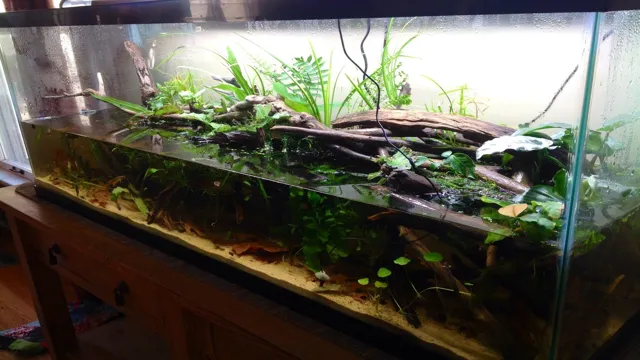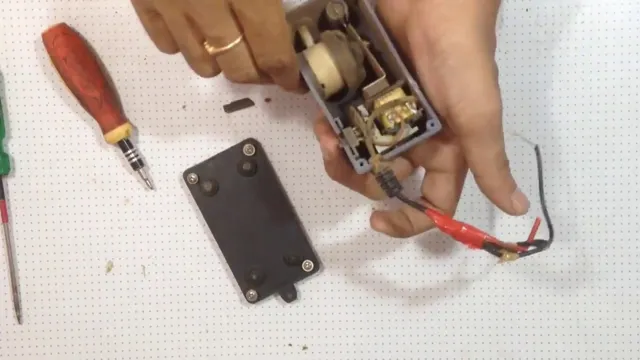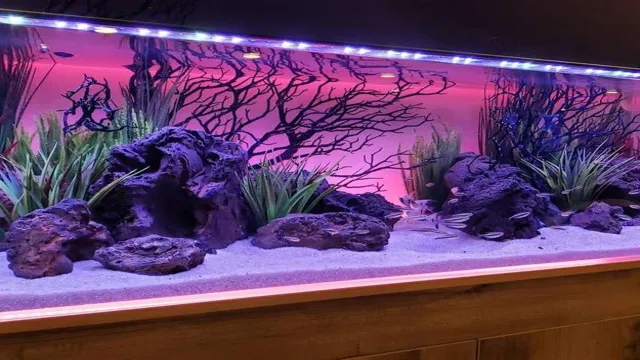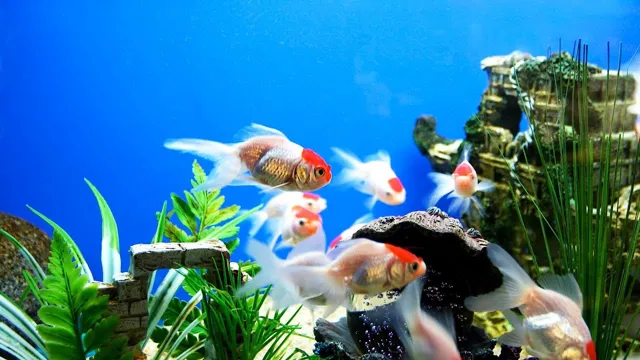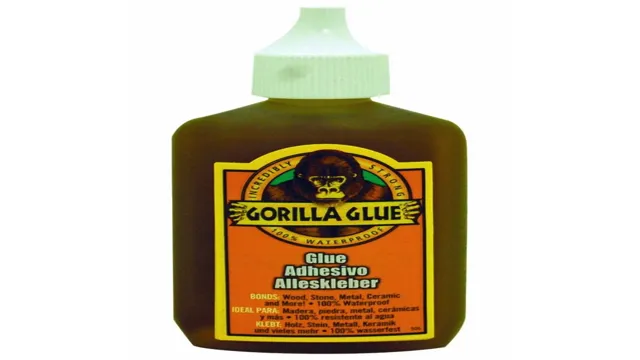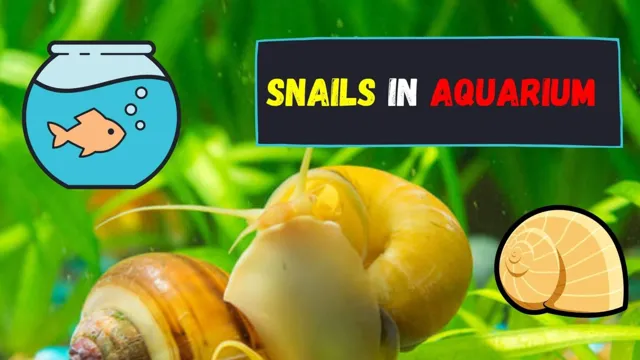Have you ever wanted to bring a piece of nature inside your home? One way to achieve this is by building your own terrarium in a 55 gallon aquarium. This project is not only a fun DIY activity but it can also be a great source of relaxation and a decorative piece in your home. Terrariums are miniature ecosystems that simulate the natural environment for plants and animals to thrive in.
Building one inside an aquarium provides a larger space for your creation and gives you the flexibility to add various types of plants and even small animals such as reptiles or amphibians. Building a terrarium in a 55 gallon aquarium may seem daunting at first, but with the right tools and materials, it can be a fulfilling experience. You can customize the design of your terrarium to fit your personal taste and the environment you wish to replicate.
In this blog, we will take you through the step-by-step process of building a terrarium in a 55 gallon aquarium. We will cover essential materials, plant selection, and how to create a healthy environment for your new pets. By the end of this blog, you’ll be equipped with the knowledge to create a beautiful and thriving terrarium in your home.
So, let’s dive in!
Materials Needed
If you’re interested in building a terrarium out of a 55-gallon aquarium, you’ll need a few things to get started. Firstly, you’ll need the aquarium itself, which can be found at most pet stores or online retailers. You’ll also want to get some substrate, like coconut coir or potting soil, to create a base layer for your plants to grow in.
Additionally, you’ll need a variety of plants, both large and small, to create a visually appealing and engaging environment. Other key materials include rocks, driftwood, and other decorative elements, which can be used to create height and depth in your terrarium. Finally, you’ll need a watering system, such as a spray bottle or watering can, to keep your plants well hydrated.
With these items in hand, you’ll be well on your way to creating a stunning and sustainable terrarium that will bring beauty and life into any room of your home.
Tank and Lid
If you’re planning to build your own tank and lid, you’ll need some materials to get started. First, you’ll need a sturdy and durable tank. You can choose from various materials such as plastic, glass, or acrylic.
Plastic is lightweight and affordable, making it an excellent option if you’re on a budget. Glass is more expensive but provides higher clarity and a more professional look. Acrylic is a popular choice since it’s lightweight and impact-resistant, making it less likely to crack or shatter.
Once you’ve chosen your tank, you’ll need a lid to keep your fish safe and prevent them from jumping out. There are various types of lids you can choose from, such as glass, plastic, or mesh. Glass lids provide higher clarity and a more professional look, while plastic and mesh lids are more affordable and easy to install.
It’s essential to choose a lid that fits perfectly to prevent any gaps between the lid and the tank. This helps to maintain a stable environment inside the aquarium and keep your fish healthy. With these materials in hand, you can start building your tank and lid and enjoy watching your fish thrive in their new home.
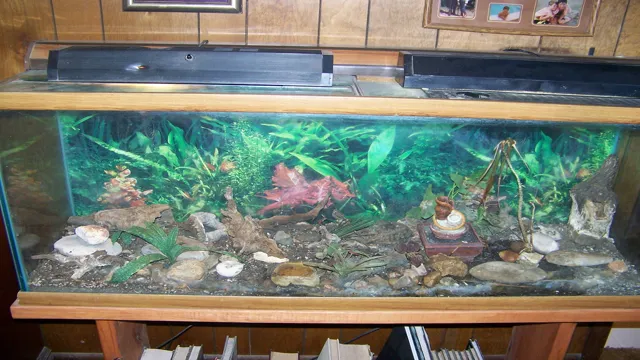
Gravel or Rocks
When it comes to creating a beautiful and functional outdoor space, choosing the right materials can make all the difference. One consideration that many people face is whether to use gravel or rocks for their landscaping needs. Both options have their benefits and drawbacks, so it’s important to weigh them carefully before making a decision.
Gravel can be a more affordable and easier-to-install option, as it can be spread out quickly and doesn’t require any special equipment. However, it can also be more prone to movement and erosion over time. Rocks, on the other hand, can offer more durability and stability, as well as a more natural and organic look.
However, they can also be more expensive and require specialized equipment to install. Ultimately, the decision between gravel and rocks will depend on a variety of factors, including budget, style preferences, and practical needs. By carefully considering these factors, you can choose the material that will work best for your outdoor space and help you create the garden of your dreams.
Potting Soil
When it comes to potting plants, choosing the right soil is crucial. The materials you need to make potting soil depend on the type of plants you are growing and the conditions they need to thrive. Generally speaking, potting soil is a mix of organic and inorganic materials that promote healthy roots and good drainage.
Some organic materials include peat moss, compost, and coconut coir. Inorganic materials such as perlite, vermiculite, and sand, help to promote drainage and aeration in the soil. The type and ratio of these materials used can vary depending on the needs of the plant, so it’s important to do your research beforehand and determine the right mix for your specific plant. (See Also: How to Make Aquarium Background Poster: A Step-by-Step Guide)
A good rule of thumb for creating potting soil is to use a blend of two to three parts organic material to one part inorganic material.
Plants
Plants are a beautiful addition to any home or garden. They not only add color and vibrancy, but also help to purify the air we breathe. When it comes to caring for plants, having the right materials can make all the difference.
The basic materials you will need to care for your plants include soil, water, sunlight, and fertilizer. Depending on the type of plant you have, you may also need a pot, pruning shears, and stakes for support. When selecting soil, it’s important to choose one that is suited for your specific plant.
The amount of water your plant needs will depend on factors such as the type of plant, the size of the pot, and the environment. Additionally, fertilizing your plant can help it stay healthy and thrive. By having the right materials on hand, you can ensure that your plants will grow strong and healthy.
Decorative Elements
When it comes to decorative elements, there’s a range of materials that can be used to add visual interest and depth to a space. Some commonly used materials for decorative elements include wood, metal, glass, and ceramics. Each material has unique properties that lend themselves to different styles and aesthetics.
Wood brings warmth and natural texture, while metals add a touch of modern glamour with their sleek, shiny surfaces. Glass can create a sense of airy transparency, while ceramics offer a handmade, artisanal feel. Depending on the look and mood you’re trying to achieve, you can mix and match these materials or focus on a single one for a cohesive look throughout your space.
Don’t be afraid to experiment and play around with different materials until you find the perfect combination that reflects your personal taste and style!
Step-by-Step Guide
If you’re looking for a fun and rewarding project, building a terrarium in a 55-gallon aquarium can be a great choice. Here’s how to get started: First, gather all the materials you’ll need, such as plants, soil, rocks, and decorations. Then, begin by filling the bottom of the tank with a layer of rocks to allow for drainage.
Next, add a layer of activated charcoal to prevent mold and bacteria growth. After that, add a layer of potting soil, ensuring that it’s level and smooth. Finally, you can start adding your plants and decorations, creating a landscape that reflects your personal style and taste.
Be sure to water the terrarium sparingly and keep it in a location with plenty of natural light. With a little creativity and patience, your 55-gallon terrarium can become a beautiful and relaxing centerpiece in your home.
Prepare the Tank
When it comes to preparing your tank, there are a few key steps you’ll want to follow to ensure the best possible environment for your aquatic pets. First, it’s important to clean the tank thoroughly. This involves removing any debris or old substrate, wiping down the interior of the tank with warm, soapy water, and rinsing it thoroughly.
Next, add your substrate to the tank, being sure to choose a type that is appropriate for your fish or other aquatic life. Once your substrate is in place, add any plants or decorations you may want to include. Finally, it’s time to fill the tank with water and add any necessary accessories, such as a filter, heater, or air stone.
By following these steps, you’ll be well on your way to creating a healthy and happy habitat for your aquatic pets to thrive in.
Add the Gravel or Rocks
Adding gravel or rocks is a crucial step in creating a beautiful and functional landscape. To begin, make sure the area is cleared of any debris and leveled out. Then, choose the type of stone or rock that will best suit the design and purpose of your landscape.
You can opt for pea gravel for a softer look or larger river rocks for a bolder statement. Once you have selected the stones, spread them evenly over the area to create a uniform layer. Use a rake or shovel to spread the gravel or rocks to the desired depth, depending on how much water drainage you need. (See Also: How to Catch Marine Aquarium Fish: Tips and Techniques for a Successful Catch)
Remember to compact the layer of stones to ensure they won’t shift or sink over time. Adding gravel or rocks not only adds texture and dimension to your landscape but also creates a functional space for walkways, patios, and more. With the right stones, your landscape will be transformed into a stunning and practical outdoor oasis.
Add Potting Soil
Adding potting soil to your plants can significantly improve their growth and overall health. But how should you go about doing it? In this step-by-step guide, we’ll walk you through the process. The first step is to choose a high-quality potting soil that is appropriate for your plant’s needs.
You can find specialized soil for cacti, succulents, tropical plants, and many others. Once you have your soil, fill your container about 2/3 full with it. Then, place your plant in the center of the pot and add more soil around it until the pot is full, leaving about a half-inch of space at the top.
Water the soil well and allow it to settle. After a day or two, you may need to add more soil to fill in any gaps that appear. Remember, proper soil can make all the difference when it comes to the health and growth of your plants.
So, take the time to choose the right soil and give your plants the care they deserve.
Plant the Terrarium
If you’ve decided to create a terrarium, congratulations – you’re in for a fun and rewarding experience! Planting the terrarium is the most critical step, and it’s essential to get it right, as it will set the stage for a healthy and thriving ecosystem. The first step is to add a layer of pebbles or small rocks to the bottom of the terrarium to allow for drainage. Next, add a layer of activated charcoal to help filter the air and prevent the growth of mold and bacteria.
Follow this with a layer of potting soil, making sure to leave enough space at the top for the plants. Carefully plant the selected mix of plants, starting with the larger plants first and working your way down to the smaller ones. Finally, add any decorative elements like rocks or figurines, and spritz the plants with water to give them a good start.
With these steps, you’re well on your way to creating a beautiful and healthy terrarium to enjoy.
Add Decorative Elements
If you’re looking to add some personality and character to your space, decorative elements are a great way to do so. These elements can come in different shapes, sizes, and colors, and they can make a room feel more alive. Here’s a step-by-step guide to adding decorative elements:
Think about the style you want to achieve. This could be anything from bohemian to minimalist, so it’s important to have a clear idea in mind before you start shopping.
Look for decorative items that match your style. This could include wall art, throw pillows, vases, or candles.
Consider color. You want your decorative elements to complement the overall color scheme in your room, so think about what will work best. You could choose a color that matches your furniture or use something that contrasts for a bold statement.
Don’t overcrowd your space. While it’s important to add decorative elements, you don’t want to go overboard.
Spread them out throughout the room for a balanced look. By following these steps, you can add decorative elements to your space with ease. The key is to remember your overall style and not to clutter your space.
Care Tips
Taking care of your belongings is essential to ensure their longevity and maintain their appearance. When it comes to home decor items, like vases or decorative plates, proper care is necessary to prevent damage and keep them looking their best. To help you take care of your cherished decor, here is a step-by-step guide. (See Also: How to Change Your Aquarium Gravel: A Step-by-Step Guide for Beginner Aquarists)
First, start by washing your hands to avoid transferring oils or dirt to the object. Next, use a soft cloth or paintbrush to remove dust or debris gently. If the object needs a deeper clean, use a mild soap and a damp cloth to gently wipe it down.
Make sure to dry it thoroughly afterward to avoid water damage. If the object is fragile or made of delicate materials, consider using specialized cleaning products or seeking professional help. Lastly, store your decor item in a safe place, away from direct sunlight or extreme temperature changes.
By following these simple steps, you can ensure the longevity and beauty of your beloved decor items.
Conclusion
In conclusion, building a terrarium in a 55-gallon aquarium is a fun and fulfilling project that allows us to create our own little world within a glass box. To achieve success, remember the three key elements of a terrarium: drainage, substrate, and plants. Don’t hesitate to experiment with different plant combinations and decorative elements to create a unique and stunning display.
Just keep in mind that no matter how impressive your terrarium turns out, it will never be as entertaining as watching your cat try to catch the resident frog. Happy building!”
FAQs
What materials do I need to build a terrarium in a 55 gallon aquarium?
You will need a 55 gallon aquarium, a substrate such as soil or sand, various plants, decorations, and a lid to control humidity.
Can I use a 55 gallon aquarium for a desert terrarium?
Yes, but make sure to use a sand substrate and choose plants suited for desert environments.
How do I maintain the humidity levels in my terrarium?
Use a misting bottle to mist the plants and substrate with water regularly, and make sure the lid is secure.
What types of plants are best suited for a terrarium in a 55 gallon aquarium?
Tropical plants such as ferns, mosses, and bromeliads are great choices.
How do I clean my terrarium in a 55 gallon aquarium?
Remove any debris or dead plant matter and wipe down the sides of the aquarium with a damp cloth. Avoid using any harsh chemicals.
Can I add live animals to my terrarium in a 55 gallon aquarium?
Yes, but do thorough research and make sure the animals are compatible with the plants and environment of the terrarium.
How often should I water my terrarium in a 55 gallon aquarium?
Water according to the needs of the plants, typically once or twice a week. Avoid overwatering as it can lead to mold and mildew growth.

